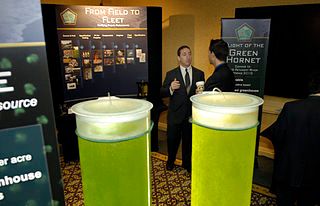From Guest Blogger Tom Grant: Worth a Second Look — Green Algae

One of the most promising forms of renewable energy is hydrogen. A ready source of hydrogen is green algae. Green algae produce hydrogen as a by-product of photosynthesis. Until recently, conventional wisdom stated that green algae production of hydrogen was an inefficient process, meaning that producing energy from green algae would be by necessity an expensive operation.
However, recent discoveries by researchers at Uppsala University, led by Senior Lecturer Fikret Mamedov and Professor Stenbj’rn Styring indicate that hydrogen production from green algae is much more efficient than earlier believed. If this is the case, green algae may indeed become an economically viable source for hydrogen energy. Organizations such as Environmental Data Resources are instrumental in recording experimental and development data in the continuing quest for sustainable energy.
Green Algae and Photosystem II
During the process of photosynthesis, water molecules are split into hydrogen ions and electrons. These ions and electrons can be combined with hydrogen gas by using special enzymes known as hydrogenases, which occur in cyanbacteria and in green algae, both of which produce hydrogen through their metabolism. Researchers have known for about fifteen years that green algae can produce hydrogen through photosynthesis, but were stumped by the fact that the amount of hydrogen produced in relationship to the process of photosynthesis was too low to be economically viable. In fact, green algae were actually no more efficient at producing hydrogen than ordinary house plants or garden plats, according to the conclusions drawn by previous researchers.
However, the findings by Mamedov and Styring found that previous researchers had actually miscalculated the efficiency of hydrogen production from green algae and Photosystem II. Instead, Mamedov and Styring found that up to 80 percent of the electrons needed for hydrogen producing hydrogenases came from Photosystem II. This figure is much higher than previous findings, and suggests that green algae are in fact a very promising source of renewable hydrogen energy.
Promise for the Future
The scientists intend to continue their experiments, encouraged by the promising possibility that they will be able to unlock a process that allows for control of the Photosystem II process. Once such control has been gained, production of hydrogen could occur on a regular schedule and in quantities designed to meet particular needs. The cost of hydrogen energy would also decrease dramatically, making it a viable source of energy to heat and cool buildings, light rooms and street corners and power motor driven vehicles. These uses alone power a significant proportion of present fossil fuel production, so gaining the ability to fill these needs sustainably would go a long way toward decreasing the total carbon footprint by human habitation.
Tom Grant is an environmental sustainability researcher. His articles mainly appear on environmental blogs.
